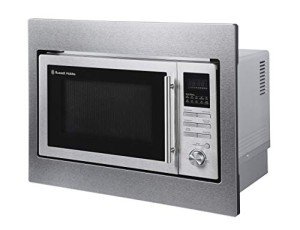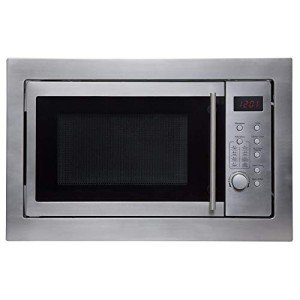The No. One Question That Everyone Working In Microwave Built Should Be Able To Answer
작성자 정보
- Winfred 작성
- 작성일
본문
 How is a Microwave Built?
How is a Microwave Built?integrated combi microwave ovens have brought home convenience to a completely new level. They can be positioned in wall cabinets or on top of kitchen islands. They are also constructed from a variety of materials.
In 1940 the cavity magnetron device emitting microwaves was created at Birmingham University in England. Percy Spencer discovered that this device could cook food after watching eggs pop and corn cook.
Raw Materials
Microwave (MW) heating is gaining a lot of attention in the field of material processing due to its inherent advantages, including quicker heating and uniform heating, as well as its non-contact nature, and low energy consumption. MW heating can be used on a variety of engineering materials, including ceramics, metals, and polymers. Recently, it has also been modified to bulk metal joining, cladding of dissimilar metallic powders on metallic substrates and casting.
Metal is the main raw material used in built-in combination microwave oven and grill ovens. It is extracted from the earth through processes that consume a lot of energy and release greenhouse gases. The other major component is plastic, which comes from organic substances that are natural like crude oil and cellulose. The production of plastic results in indirect greenhouse gas emissions through the use of fossil fuels to produce electricity and heat as well as direct emissions from chemical processing, for example the production of phthalates and bisphenol A.
Once the raw materials are procured, they are subjected to rigorous manufacturing and quality control to ensure they meet strict federal standards. In the process of manufacturing, various wastes and emissions, such as solvents, dust and oils are produced. The finished product will be shipped to retailers and ultimately to the consumer. Most microwaves are transported by truck, which consumes an enormous amount of energy and generates greenhouse gases.
Once the microwave is purchased, it is typically used for a number of years before it becomes obsolete and being removed. Microwaves are not long-lasting, so recycling and disposal at the end of their life options are vital to reduce emissions and waste.
Design
Microwave ovens cook food by emitting electromagnetic waves within the microwave region (300 MHz to 300 GHz). The microwave oven cooks food by passing the radiation through it. The microwave ovens are designed to protect against harmful effects caused by radiation, such as the arcing of radiation that can damage the oven and the food that is cooked inside. There are many different types of microwave ovens on the market. Each one has its own pros and pros and. When choosing a microwave take into consideration the size of your kitchen and also your cooking needs. For instance, if you have a small counter space, you might want to consider an integrated microwave oven model that can be tucked away the appliance away.
The design of a microwave oven starts with the purchase of raw materials. These are then processed into various components. The oven's cavity and frame are two of them, as are the turntable, glass tray, and magnetron tube, which includes capacitor and transformer. The casing is composed of metals like aluminum steel or galvanized steel, or brass.
The microwave is packaged and tested following assembly. The packaging is typically made of recycled materials, such as paper and cardboard or recyclable plastics such as polyethylene terephthalate, or polyvinylchloride.
The new microwave is transferred to transportation tools, such as aircrafts, ships or automobiles. These tools make use of fossil fuels to transform chemical energy into mechanical energy which is used to move microwaves to the customers. Once the microwaves have been delivered to the customer, they can be connected by the user and utilized. This is the most energy-consuming stage in the life cycle and generates emissions like carbon dioxide.
Manufacture
Microwave ovens are one of the most used appliances in modern kitchens. What is it that makes a microwave work? To find out, let's take an overview of the process of putting together this essential appliance in your home.
Metals, plastic parts, and other electrical components are the raw materials required to make microwave. Certain of these components are found in the earth, while others require processing. The process of manufacturing is energy-intensive, which results in greenhouse gas emissions. This stage of production is the source of much of a microwave's environmental impact.
In the manufacturing process, most of the material is assembled by automated machines. The assembly process is carried out in the factory where workers are placed on a conveyor. Workers utilize a machine for making sheet metal into the outer casing as well as the door. Once the frame is made, it is rinsed in an alkaline cleaner in order to remove oil and dirt. It is then assemble with screws and bolts to create a safe chassis for the inside cavity.
Magnetrons and other components are able to be put in after the chassis has been constructed. The magnetron emits microwaves which cause water molecules to get hotter. During this phase there could be safety hazards, such as the risk of plasticizers leaching into food and the possibility of the oven exploding when it is empty.
When the microwave is assembled, it undergoes rigorous testing and inspection to make sure that it meets federal standards. After this step the microwave is then packaged for distribution to consumers. The transport of microwaves from the factory and retailers can be a significant environmental burden. The transport tools used to deliver microwaves are powered by fossil fuels that release greenhouse gases and carbon dioxide into the air.
Testing
Microwaves are a form of electromagnetic radiation that forms part of the electromagnetic spectrum of waves. This spectrum is made up of various kinds of energy that move through space, such as radio waves, visible light infrared energy, ultraviolet radiation. Microwaves can heat food using the process of microwave heating, which makes use of electromagnetic radiation to cause the water molecules in food to move and rotate. This allows food to be heated without heating the air around it or changing its physical structure.
Microwaving food is a safe method to heat food since the microwave radiation doesn't affect the food's cells, nor does it make it radioactive. However, people with pacemakers should avoid microwaves because the radiation could interfere with the electrical signals of certain electronic cardiac devices. This problem has been solved by using a special shielding.
Bisphenol A (BPA) along with phthalates and other chemicals found in microwave ovens can be detrimental to your health. Several studies have shown that BPA is able to leach from plastic containers into food items, and phthalates may be associated with an increased risk of developing reproductive problems. Additionally microwave radiation may cause damage to the eye tissue and cause cataracts.
In the present NOPR tests, the procedures require that microwaves be tested in their microwave-only cooking mode as well as convection microwave cooking modes to assess the energy consumption of appliances under typical usage conditions. The test method makes use of mixtures of water and basic ingredients from food that are designed to simulate actual foods that are reheated in the microwave. The mixtures are then poured into a borosilicate glass container that is heated in the microwave oven, and later evaluated for their thermal efficiency.
Packaging
A large portion of microwave-ready meals utilize an exclusive packaging method known as modified atmosphere packaging (MAP). This method of packaging utilizes oxygen-eliminating gases to extend the shelf life of pre-prepared foods. These gases are typically composed of carbon dioxide, oxygen pure as well as nitrogen, and they operate by removing oxygen from the food's environment. This prevents spoilage and extends the shelf-life of the meal.
The MAP method is also used to package meat products such as frozen steaks or patties of beef. These packages contain a nonwoven film, which absorbs moisture and helps keep the food moist and fresh for a longer period of time. This kind of packaging reduces consumption since it reduces amount of water and air that is lost during the heating process.
 When choosing a microwave, consumers should take into consideration its size and power level as well as other features, such as sensor cooking or defrost options. These features can make cooking more comfortable, but it's also important to consider how often these functions will be used in order to avoid paying for a microwave that has additional features that will remain in use for the majority of the time. Another thing to consider is the design of the microwave. Some models have a flush-built in double oven and microwave combination in microwave for 600mm wall unit (google.com.sb)-in design which fits seamlessly into existing cabinets.
When choosing a microwave, consumers should take into consideration its size and power level as well as other features, such as sensor cooking or defrost options. These features can make cooking more comfortable, but it's also important to consider how often these functions will be used in order to avoid paying for a microwave that has additional features that will remain in use for the majority of the time. Another thing to consider is the design of the microwave. Some models have a flush-built in double oven and microwave combination in microwave for 600mm wall unit (google.com.sb)-in design which fits seamlessly into existing cabinets. 관련자료
-
이전
-
다음
댓글 0
등록된 댓글이 없습니다.
